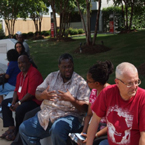Sankofa Journey
November 1, 2012
 This fall, New Brunswick Theological Seminary took another step toward its stated goal of being an anti-racist institution: it offered M.Div. students a chance to participate in a Sankofa journey for credit. Initially, the trip was jointly sponsored by NBTS and Western Theological Seminary and was coordinated by Earl James, the RCA’s coordinator for multiracial initiatives and social justice.
This fall, New Brunswick Theological Seminary took another step toward its stated goal of being an anti-racist institution: it offered M.Div. students a chance to participate in a Sankofa journey for credit. Initially, the trip was jointly sponsored by NBTS and Western Theological Seminary and was coordinated by Earl James, the RCA’s coordinator for multiracial initiatives and social justice.
Sankofa is a three-day, cross-ethnic bus trip designed to help Christians move toward righteous responses to racism and grow to understand and value each other. Each participant is paired with another participant of a different race, and partners discuss and process their experiences together throughout the journey. Participants visit historic sites important to the civil rights movement, including the Edmund Pettus Bridge in Selma, Alabama, and the Sixteenth Street Baptist Church in Birmingham, Alabama. Along the way, they watch videos and listen to the stories of people who have experienced the pain of racism firsthand. Sometimes, these stories come from participants themselves.
Realizing that not all students are equally well-acquainted with some of Sankofa’s topics, NBTS assigned participants homework ahead of time to better prepare them for the experience. Students were given a reading list that included a choice of several books about the history of the civil rights movement as well as a book about the cities they’d be visiting. They were also required to spend some one-on-one time with their partners in order to begin to build a relationship before the start of the journey.
The idea for a joint NBTS-WTS Sankofa trip arose in January 2012 during a Sankofa trip for Western Theological Seminary students. Earl James and WTS professor Leanne Van Dyk were discussing how Sankofa could play a role in seminary education. “We were talking about the impact on students that were on that trip, dreaming about how to think about the formation and preparation of ministers to serve in increasingly complex communities,” says James. “How might Sankofa help prepare ministers in training?
“Out of that came the thought that what’s true for one seminary would be true for others. That evolved into doing a joint trip.”
Western, located in Holland, Michigan, turned to its fellow RCA seminary, New Brunswick, which has campuses in New Brunswick, New Jersey, and Queens, New York. The trip took place September 6-9, 2012. Ten M.Div. students from New Brunswick, led by acting dean of the seminary Willard Ashley and Associate Professor Beth Tanner, flew to Grand Rapids, where they met up with the others to begin their journey.
When the trip was announced last spring, NBTS students jumped at the opportunity. All 10 spots were claimed within a few days of the announcement. Ashley says that going forward, NBTS plans to offer a Sankofa experience at least once a year, and hopefully more often.
NBTS is committed to continuing Sankofa as an educational tool in the future. Right now the Sankofa journey is an elective experience for NBTS students, but Ashley and others hope it will become a required part of M.Div. coursework. “Our board of trustees voted some years ago for us to be an anti-racist seminary,” he says. “Some students don’t have an appreciation for the history and why we do this.
Ashley says that Sankofa’s one-on-one time with someone of another race plays an important role in ministerial formation by creating authentic interracial relationships. “Hopefully there’s enough comfort where you can ask questions you’ve always wanted to ask,” says Ashley. “Why do we have to work to bring about change? Hopefully you can process, have an ‘aha’ moment.”
He says the Sankofa experience will also help future ministers learn to apply classroom knowledge in culturally complex situations. “They’ll get the message [that] the analysis we teach in the classroom works in real life. It’s not always neatly laid out for you; sometimes you have to work a little harder to find why this is important for me as a clergy member. What are the benefits and what are the costs?
“I tell my students that if you want to be a change agent, it costs you something. Each person has to make a determination if they’re willing to pay whatever the cost–that cuts across racial lines. If you’re going to stand for racial justice, that comes at a cost.
“What we really hope is that students come back and make an impact on the seminary. We had some doctoral students and alumni who wanted to go, but we would really rather have master of divinity students go–they’re the best teachers to their classmates and colleagues. They’ll come back and say, ‘This is why you should go. This is why this was transformative for me!'”
